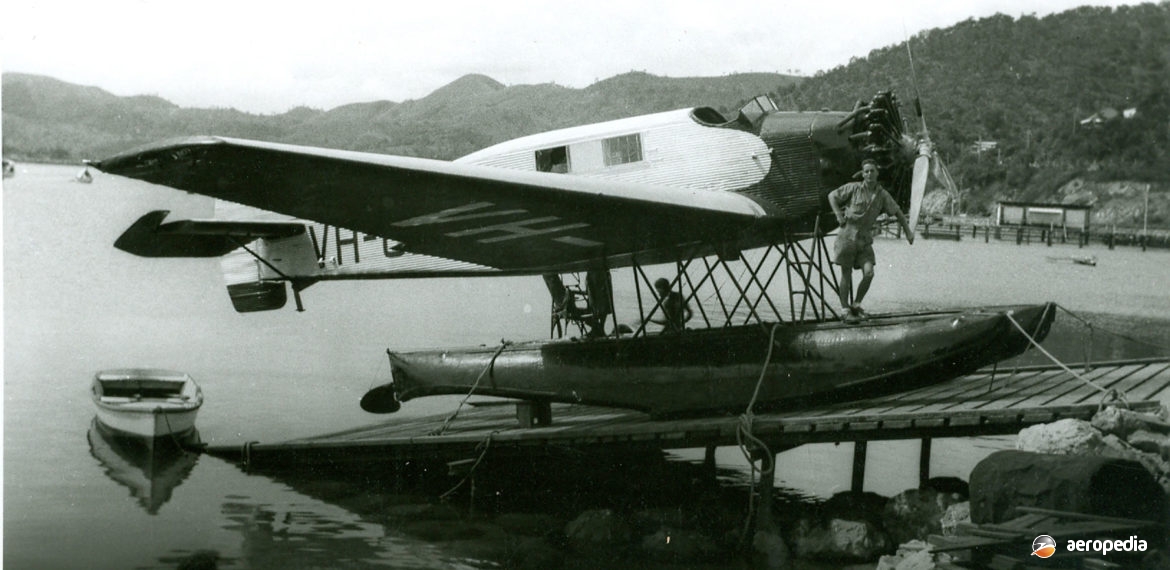Photograph:
Junkers W 34 VH-UNM (c/n 2619) whilst operating in New Guinea (Reddall collection -AHSA NSW)
Country of origin:
Germany
Description:
General purpose commercial transport
Power Plant:
(W 34d)
One 448 kw (600 hp) BMW Hornet nine-cylinder air-cooled radial engine
Specifications:
- Wingspan: 18.48 m (60 ft 7½ in)
- Length: 11.13 m (36 ft 6¼ in)
- Height: 3.53 m (11 ft 7 in)
- Wing area: 44 m² (473.6 sq ft)
- Max speed at sea level: 247 km/h (153 mph)
- Max cruising speed at 1,000 m (3,280 ft): 210 km/h (130 mph)
- Landing speed: 116 km/h (72 mph)
- Climb to 1,000 m (3,280 ft): 4 mins
- Service ceiling: 5,300 m (17,380 ft)
- Absolute ceiling: 6,000 m (19,600 ft)
- Range at cruising speed with standard tanks: 870 km (540 miles)
- Empty weight: 1,625 kg (3,580 lb)
- Disposable load: 1,575 kg (3,470 lb)
- Loaded weight: 3,200 kg (7,055 lb)
History:
The W 34 series was developed concurrently with the W 33 sseries by Junkers, using virtually an identical basic design. Both were refinements of the F 13 and built as general purpose transports. Production continued throughout the years 1927 to 1934.
The prototype of the W 33 / W 34 series (D-922) was powered by a 313 kw (420 hp) Gnome Rhone Jupiter VI engine and was fitted with floats. The first production aircraft, the W 34b, had this engine but a variety of models appeared, including the W 34d, W 34fi, W 34fue, W 34gi and W 34hi, all powered by the 448 kw ( 600 hp) BMW Hornet engine; the W 34fao and W 34flao seaplanes, and the W 34fei, with the 403 kw (540 hp) Siemens Sh20 engine; the W 34fy with the Armstrong Siddeley Panther engine; the W 34h with the Bristol Mercury VI engine; and the W 34ci, W 34fa, W 34fo, etc.
The W 34 carried a crew of two and six passengers, and was of all-metal construction with corrugated duralumin skinning. Large numbers served with Luftwaffe units before and during World War II. The type also saw service with airlines in Europe, South America, Canada and New Guinea. One example set a world endurance record by staying airborne for 65 hrs 25 mins in July 1928, breaking the record held by a Junkers W 33.
Examples were supplied to the Colombian Air Force and the survivors were taken over by the Luftwaffe during World War II for advanced flight training, blind flying training, and as light transports. At least five were operated by Luft Hansa, most surviving up to 1938. Other operators included Lloyd Aereo Boliviana, Eurasia Aviation Corporation in China and Syndicato Condo in Brazil. A total of about 100 was built, a number of which were built in Sweden by AB Flygindustri.
Five W 34s were registered in Australia. A W 34b VH-UGZ (c/n 2601) arrived in Papua New Guinea in 1928 by ship in crates and was assembled on a beach and fitted with floats. It was flown to Salamaua where the floats were removed and it entered service in the freight and passenger carrying role. On 14 April 1928 it was flown to Wau with two passengers and 1,043 kg (2,300 lb) of cargo. It remained on wheels for the rest of its life. It was registered to Guinea Airways in March 1930 but was destroyed in a crash at Wau on 6 March 1930.
Another W 34b VH-UJD (c/n 2604) arrived in Melbourne, VIC in November 1928 and was assembled at Point Cook, VIC as a seaplane. Pard Mustar left in the aircraft for Papua New Guinea on 13 December 1928, this machine having a Bristol Jupiter 4 engine. It reverted to landplane configuration at Lae but in January 1931 at Bulolo the undercarriage collapsed and it was written off.
The next W 34d VH-UNM (c/n 2610) was imported for Guinea Airways and registered on 5 March 1930. In February 1942 it was impressed by the Royal Australian Air Force (RAAF) as A44-3. At this time it was on floats and was flown to Rathmines, NSW for training. However, spares were in short supply and in November that year it was transferred to No 1 Aircraft Depot (AD) at Adelaide, SA. Then, in June 1943, it was converted to components at Rathmines, as it was not considered suitable for further use.
Another W 34d VH-UNR (c/n 2611) was registered to Guinea Airways in March 1930 and operated on freight services but on 22 May 1931 it was lost near Lae when it crashed into the side of a mountain.
The next machine, a W 34f VH-UOX (c/n 1368), was registered to Guinea Airways in March 1931 and operated until impressed by the RAAF in July 1942 as A44-2. It saw service with Nos 24 and 33 Squadrons, going to No 1 AD in Adelaide in November 1942 for storage. In June 1943 it was not considered suitable for further use and was converted to components.
A couple of W 34s have survived overseas: one (SE-BVA) preserved in the Arlanda Airport Museumin Sweden; one (serial 407) in the Museo Aeronautico at Bogota, Colombia; and another CF-ATF (c/n 2718) in the Canadian National Aviation Museum in Ottawa. This latter machine continued flying up until September 1962 when it was retired. The fuselage and centre-section of a W 34 have survived at Alexishafen in Papua New Guinea.

